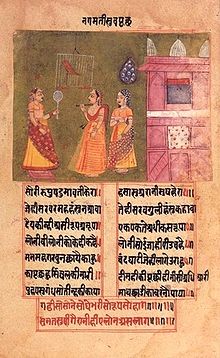Nagmati
| Nagmati | |
|---|---|
| Maharani of Mewar | |
 Queen Nagmati talks to her parrot, an illustrated manuscript of Padmavat from c. 1750 CE | |
| Spouse | Ratan Sen |
| Religion | Hinduism |
Nagmati was, according to legend, the first wife and chief queen[1] of King Ratan Sen (identified with Ratnasimha), the Rajput ruler of Medapata (present-day Mewar).[2] Nagmati plays an important role in Malik Muhammad Jayasi's epic poem Padmavat.
In Padmavat
In Padmavat, an epic poem written by Malik Muhammad Jayasi in 1540,[3] Nagmati is said to have been King Ratan Sen's first wife and chief queen, the head of his harem.[4] She awaits happily as her husband returns home to Chittor, but the happiness turns to jealousy and contempt when she hears that he has taken a second wife, Padmavati, the beautiful princess of the Sinhala Kingdom. Ratan Sen assures an insecure Nagmati that as his first wife, she is still the most dear to him.[5]
Nagmati and Padmavati develop a rivalry of sorts, each vying for their husband's attention and love. Initially, Ratan Sen placates them by spending nights with them alternately, but then establishes peace by reprimanding them.[6] After arriving in Chittor, the news of Padmavati's beauty reaches Alauddin Khilji, the Sultan of Delhi. His demand that she is handed over to him is refused, whereupon he marches to and besieges Chittor. Alauddin captures Ratan Sen in a deceitful manner and takes him back to Delhi as a prisoner. Ratan Sen is later able to escape with his two faithful warriors - Gora and Badal. Shortly afterwards, Ratan Sen is defeated and killed in a battle against King Deopal of Kumbhalgarh. Both Nagmati and Padmavati commit jauhar (the Hindu custom of mass self-immolation) along with other women of the fort after Ratan Sen's death to protect their honour from Alauddin Khilji, who successfully conquers Chittor Fort.[7]
In popular culture
- Nagmati is portrayed by Anupriya Goenka in the Indian historical film Padmavat.[8]
References
- ^ Shobha, Savitri Chandra (1996). Medieval India and Hindi bhakti poetry: a socio-cultural study. Har-Anand Publications. p. 77.
- ^ Sen, Sailendra Nath (1999). Ancient Indian history and civilization (Second ed.). New Delhi: New Age International. p. 338. ISBN 9788122411980.
- ^ Metcalf, Barbara D. (2009). Islam in South Asia in Practice. Princeton: Princeton University Press. p. 63. ISBN 9781400831388.
- ^ Jackson 1996, p. 428.
- ^ Jackson 1996, p. 430.
- ^ Ramya Sreenivasan 2007, p. 208.
- ^ Jafri, compiled by Saiyid Zaheer Husain Jafri, Syed Hasan Muzzamil (2010). Essays on literature, history & society : selected works of Professor Syed Naqi Husain Jafri. Delhi: Primus Books. p. 49. ISBN 8190891855.
{{cite book}}: CS1 maint: multiple names: authors list (link) - ^ "Padmavati: The mystery of Ghoomar's unknown woman solved. This is who she is". The Hindustan Times. 28 October 2017. Retrieved 11 November 2017.
Bibliography
- Jackson, Guida M. (1996). Encyclopedia of literary epics. Santa Barbara, Calif. [u.a.]: ABC-CLIO. ISBN 9780874367737.
- Ramya Sreenivasan (2007). The Many Lives of a Rajput Queen: Heroic Pasts in India C. 1500–1900. University of Washington Press. ISBN 978-0-295-98760-6.
{{cite book}}: Invalid|ref=harv(help)
